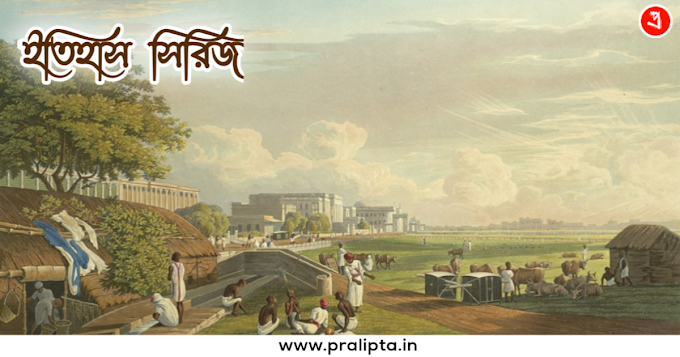Dr. Nisith R. Ray: People living in Chinsurah today are reminded of the traders from the Netherlands who for nearly two centuries ruled over it . It is perhaps a small consolation that rhey did not come under British tutelage till nearly seventy years had elapsed after Plassey . In fact , the story of foreign domination in Chinsurah is a little older than that of the British occu- pation of the rest of Bengal . The Nawab to whom the Subah belon- ged de facto , had given to the Dutch East India Company the right to set up a trading establishment in Chinsurah in C. 1632 , i . e earlier than he had confirmed the same right to the English merchants so far as Sutanuti and its immediate vici- nity was concerned . The Dutch , who had been conceded the right to trade in Bengal , enjoyed territorial autho- rity only in two sides Chinsurah and Baranagar . It is not our purpose to trace the relations between the Dutch and the British vis - a - vis the Nawab . That story is intricate , even though it is evident that unlike the British . the Dutch had no territorial ambition so mainland of India is far as the concerned . The main object of their interest and activities was con- cerned with the Spice Islands , later known as the Dutch East Indies .The British rule in Chinsurah after the elimination of the Dutch Power in Bengal lasted a little over 120 years , much less than the duration of Dutch control ( 1632-1825 ) . It was certainly an exaggeration when a visiting Briton wrote that when the time for the Britishers to leave India would come nothing but empty bear bottles would bear witness to their rule . What the writer probably wanted to convey was that his countrymen in Ir dia were not as great builders as their predecessors , viz . the Mughals . Even then the buildings of the British period were magnificent enough , by any standard . The Dutch in Bengal could not compete with the Britishers as builders whose rule spread over nearly the whole of india by the mid 19th century .
In spite of comparative limitations , the Dutch town of Chinsurah did indeed possess a number of hand- some buildings . The Rijks Museumh , Amsterdam , possesses an oil on the general lay - out of the Dutch factory in Chinsurgh by Hendrick Van Schuy- lanburah , dated 1665. In the words of an art - historian , the main buil- ding occupied three sides of a square , the principal part being two storeyed and farming the living quar- ters of the Director and the principal offices , while in the wings were warehouses for the valuable goods . Other warehouses were built round the inside of the perimeter wall of the compound . Fresh water and gardens were obviously of great im- portance The whole area was surro- unded by a wall . Streyusham Master in his Dairy ( 1676 ) describes the Dutch factory as ' a large well - built house standing by itself much like a country seat in England ' . He alsorefers to well - kept warehouse , ' spacious walls ' , full of lattice and good herbage ' . William Hodges , the celebrated artistt - raveller from Erg- land , has also left for us two aqua entitled ' View of Chiusurah ' and ' The Dutch Settlement in Bengal ' in his select views of India drawn on the spot ( 1780-83 ) .
Perhaps the most remarkable among the local architectural works was the Armenian Church , attesting to the fact that a large number of Armenian merchants had settled there . The Church was built in 1685 by Margar Johannes , described in his memorial tablet as ' a consi- derable merchant , honoured with the favours of Kings and their Viceroys .. and widely travelled north , south , east and west . There are a number of tombs the period 1712 and 1852 .
The Dutch Church built in 1767 , later converted into an English Church con- tained tablets and inscriptions dating back to August , 1662. The Roman Catholic Church came up later , pro- bably before 1853. Part II of the List of Inscriptions on Tombs or Monum- ents in Bengal published during the Lt. of Sir Charles Elliot contains a list
of names of individualy cremated in the Church Yard , The dates vary bet- 52 ween 1683 and 1853 . These men and women who are long dead are totally forgotten today , but rious ways , were makers of they , in various ways , were makers of history the age they lived in , were makers of history , along with con- temporary Indians who worked to- wards making Chinsurah what it was as the early days of colonial and me- rcantile adventures in Bengal .
It is also relevant to refer to a special item of painting , which has earned , of late , the name of Dutch School of Painting . There is evidence that the school flourished in and near the Dutch settlement in Bengal . The subject depicted there are deities and mythological figures . An in - depth scholarly study is still awai- ted . If only the India Netherlands Friendship Society could undertake a listing of these paintings , both the public and private custody of these paintings , indicating therein , as far as possible , their pre- vence , subject , date and above all the artists ' name signed or otherwise . Our art - historians may well be ex- pected to follow up and assess their value and relevance in the history of modern art in India .





















